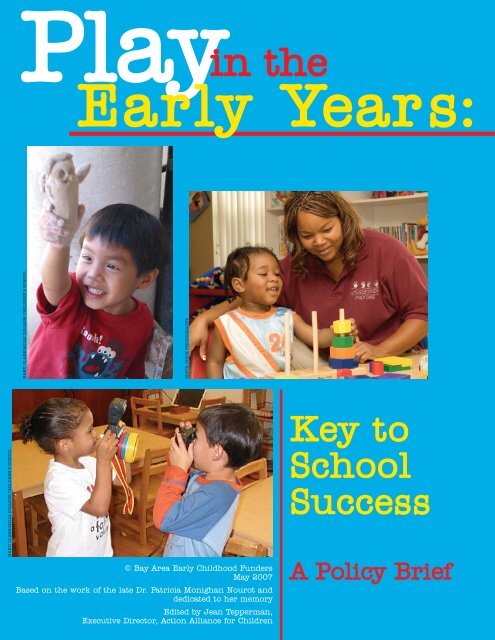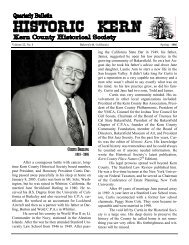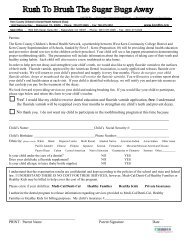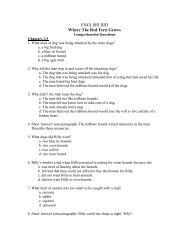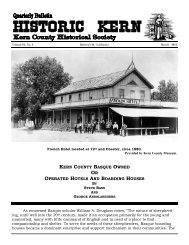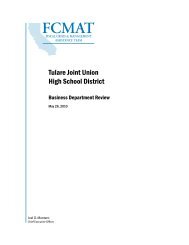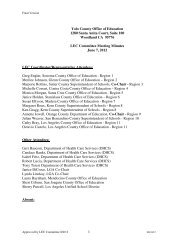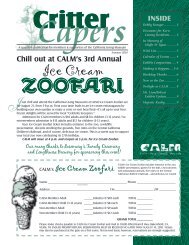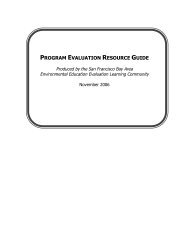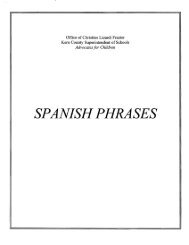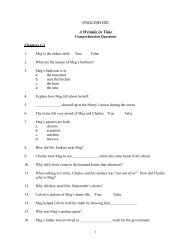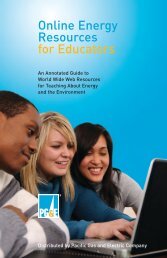Play in the Early Years - Mayo County Childcare Committee
Play in the Early Years - Mayo County Childcare Committee
Play in the Early Years - Mayo County Childcare Committee
Create successful ePaper yourself
Turn your PDF publications into a flip-book with our unique Google optimized e-Paper software.
<strong>Play</strong><br />
<strong>in</strong> <strong>the</strong><br />
<strong>Early</strong> <strong>Years</strong>:<br />
NANU CLARK/MILLS COLLEGE CHILDREN’S SCHOOL<br />
NANU CLARK/MILLS COLLEGE CHILDREN’S SCHOOL<br />
STEVE FISCH PHOTOGRAPHY<br />
© Bay Area <strong>Early</strong> Childhood Funders<br />
May 2007<br />
Based on <strong>the</strong> work of <strong>the</strong> late Dr. Patricia Monighan Nourot and<br />
dedicated to her memory<br />
Edited by Jean Tepperman,<br />
Executive Director, Action Alliance for Children<br />
Key to<br />
School<br />
Success<br />
A Policy Brief
<strong>Play</strong> <strong>in</strong> <strong>the</strong> <strong>Early</strong> <strong>Years</strong>:<br />
Key to School Success<br />
Pour<strong>in</strong>g water<br />
<strong>in</strong>to different<br />
size conta<strong>in</strong>ers,<br />
<strong>the</strong>se children<br />
learn about<br />
volume and<br />
measurement<br />
while develop<strong>in</strong>g<br />
<strong>the</strong>ir eye-hand<br />
coord<strong>in</strong>ation.<br />
The education of young children has been <strong>the</strong> center of unprecedented attention <strong>in</strong> recent<br />
years. In California and elsewhere, this attention has generated significant efforts to offer<br />
high-quality preschool to every child. Much of this <strong>in</strong>terest has been based on new research on<br />
bra<strong>in</strong> development, which shows that <strong>the</strong> very structure of <strong>the</strong> bra<strong>in</strong> is powerfully shaped by<br />
early experiences.<br />
At <strong>the</strong> same time, this and o<strong>the</strong>r research has demonstrated that young children learn<br />
differently from older children and adults. It is essential that early childhood programs do not<br />
simply attempt to teach preschoolers <strong>the</strong> same material with <strong>the</strong> same<br />
methods that are now used <strong>in</strong> grades K-12.<br />
NANU CLARK/MILLS COLLEGE CHILDREN’S SCHOOL<br />
There is a well-established consensus among early childhood<br />
professionals that play is an essential element of developmentally<br />
appropriate, high-quality early education programs (Alliance for<br />
Childhood, 2006; NAEYC & NAECSSDE, 2003). <strong>Play</strong> provides benefits for cognitive,<br />
social, emotional, physical, and moral development (American Academy of<br />
Pediatrics, 2006; Elk<strong>in</strong>d, 2007) for children from all socio-economic, cultural, and<br />
l<strong>in</strong>guistic backgrounds (Zigler, E. & Bishop-Josef, S., 2006). To provide <strong>the</strong>se<br />
benefits, play must be consciously facilitated by skilled teachers, who are<br />
well-tra<strong>in</strong>ed <strong>in</strong> observ<strong>in</strong>g children and <strong>in</strong> understand<strong>in</strong>g how play<br />
contributes to <strong>the</strong> children’s mastery of concepts and skills.<br />
Most Americans from all cultural backgrounds are more familiar with<br />
“direct <strong>in</strong>struction” teach<strong>in</strong>g methods based on teach<strong>in</strong>g discrete skills<br />
isolated from children's <strong>in</strong>terests and activities. But research shows that<br />
<strong>the</strong> exploratory and creative activity that young children <strong>in</strong>itiate <strong>the</strong>mselves (play) is <strong>the</strong><br />
primary way <strong>the</strong>y develop concepts and understand<strong>in</strong>g about <strong>the</strong> world. <strong>Play</strong> helps children<br />
develop <strong>the</strong> skills necessary for critical th<strong>in</strong>k<strong>in</strong>g and leadership. <strong>Play</strong> is how children learn to<br />
solve problems and to feel good about <strong>the</strong>ir ability to learn.<br />
A play-centered preschool curriculum is not a laissez-faire approach. It's not <strong>the</strong><br />
same as giv<strong>in</strong>g children "free play" separate from "teach<strong>in</strong>g." Ra<strong>the</strong>r, teachers use <strong>the</strong><br />
power of children's develop<strong>in</strong>g ideas, <strong>in</strong>terests, and competencies to promote learn<strong>in</strong>g—<br />
through play, circle-time, and small-group activities. This power is most evident <strong>in</strong> children's<br />
play, as play is <strong>the</strong> central force <strong>in</strong> <strong>the</strong> development of young children.<br />
<strong>Play</strong> is not a break from <strong>the</strong> curriculum; play is <strong>the</strong> best way to implement <strong>the</strong><br />
curriculum.<br />
This policy brief focuses on play as an essential foundation for develop<strong>in</strong>g children’s ability to<br />
succeed <strong>in</strong> school and <strong>in</strong> life.
High-quality preschools provide last<strong>in</strong>g benefits<br />
In high-quality preschools, well-tra<strong>in</strong>ed early childhood teachers use children's ideas, <strong>in</strong>terests,<br />
and activities to guide <strong>the</strong>ir learn<strong>in</strong>g. In such programs, children make choices among<br />
developmentally appropriate activities.<br />
Such child-<strong>in</strong>itiated activities were key components of <strong>the</strong> high quality preschool programs<br />
that showed strong evidence of success <strong>in</strong> three major longitud<strong>in</strong>al studies. These studies<br />
found that <strong>the</strong> programs saved taxpayers between $2.69 and $7.14 for every dollar <strong>in</strong>vested<br />
(Gal<strong>in</strong>sky, 2006), by reduc<strong>in</strong>g special education, law-enforcement, and o<strong>the</strong>r costs.<br />
O<strong>the</strong>r studies provide evidence that highly structured, scripted, primarily teacher-directed<br />
<strong>in</strong>struction is not as effective <strong>in</strong> promot<strong>in</strong>g young children’s academic success as is teach<strong>in</strong>g<br />
that supports and extends children’s self-<strong>in</strong>itiated activities and <strong>in</strong>terests. In fact, research<br />
suggests that over-use of didactic teach<strong>in</strong>g can suppress child-<strong>in</strong>itiated learn<strong>in</strong>g and<br />
underm<strong>in</strong>e young children’s self-confidence and motivation to learn (Chang, Stipek & Garza, 2006;<br />
Shonkoff & Phillips, 2000; S<strong>in</strong>ger, Gol<strong>in</strong>koff & Hirsh-Pasek, 2006).<br />
<strong>Play</strong> contributes to school success <strong>in</strong> many ways<br />
A grow<strong>in</strong>g body of research shows that every competency important to school success is<br />
enhanced by play (Isenberg & Quisenberry, 2002; S<strong>in</strong>ger, 2006). For example, high-quality pretend play is<br />
related to children’s abilities to beg<strong>in</strong> to th<strong>in</strong>k abstractly and to take <strong>the</strong> perspectives of o<strong>the</strong>rs<br />
(Bergen, 2002; Berk, Mann & Ogan, 2006; S<strong>in</strong>ger, S<strong>in</strong>ger, Plason & Schweden, 2003). Connections between <strong>the</strong><br />
complexity of children’s pretend play and early literacy, ma<strong>the</strong>matical th<strong>in</strong>k<strong>in</strong>g, and problemsolv<strong>in</strong>g<br />
are documented <strong>in</strong> this research literature (S<strong>in</strong>ger et al., 2006; Smilansky, 1990; Van Hoorn, Nourot,<br />
Scales & Alward, 2007).<br />
WHEN CHILDREN PLAY:<br />
▼ They have many opportunities to apply mental representations of <strong>the</strong> world to new objects,<br />
people, and situations—<strong>the</strong> key ability for future academic learn<strong>in</strong>g.<br />
▼ They <strong>in</strong>tegrate all types of learn<strong>in</strong>g—physical, social, emotional, <strong>in</strong>tellectual, and language<br />
development.<br />
▼ They are engaged <strong>in</strong> th<strong>in</strong>gs <strong>the</strong>y’re <strong>in</strong>terested <strong>in</strong>—so <strong>the</strong>y have a natural motivation to<br />
learn (Shonkoff & Phillips, 2000).<br />
▼ Children develop concepts and skills toge<strong>the</strong>r as <strong>the</strong>y are <strong>in</strong>tegrated <strong>in</strong> <strong>the</strong> context of<br />
mean<strong>in</strong>gful and playful experiences. For example, as four-year-old Cecily learns to write <strong>the</strong><br />
letters <strong>in</strong> her name, she is also learn<strong>in</strong>g <strong>the</strong> concept that each letter<br />
represents a sound—and she is highly motivated by <strong>the</strong> mean<strong>in</strong>g:<br />
her own name. Skills have limited value without concepts. For<br />
example, it doesn’t do a child any good to be able to count to<br />
five by rote unless she understands <strong>the</strong> quantity represented<br />
(5 = five blocks).<br />
◆ Children are more likely to reta<strong>in</strong> skills and concepts <strong>the</strong>y<br />
have learned <strong>in</strong> mean<strong>in</strong>gful contexts.<br />
◆ Concepts are developed through activities that occur<br />
naturally dur<strong>in</strong>g play, such as count<strong>in</strong>g, sort<strong>in</strong>g,<br />
sequenc<strong>in</strong>g, predict<strong>in</strong>g, hypo<strong>the</strong>siz<strong>in</strong>g, and evaluat<strong>in</strong>g.<br />
BETTY RAPPAPORT/KUMARA SCHOOL<br />
As <strong>the</strong>y design<br />
and build a<br />
slop<strong>in</strong>g<br />
structure, <strong>the</strong>se<br />
girls are<br />
experiment<strong>in</strong>g<br />
with basic<br />
pr<strong>in</strong>ciples of<br />
physics<br />
and logic.
Children learn specific competencies related<br />
These boys are<br />
us<strong>in</strong>g blocks to<br />
symbolize <strong>the</strong><br />
build<strong>in</strong>gs<br />
of a city.<br />
These<br />
children are<br />
explor<strong>in</strong>g and<br />
experiment<strong>in</strong>g<br />
with materials<br />
<strong>in</strong> different<br />
ways, guided<br />
by <strong>the</strong>ir own<br />
curiosity.<br />
The development of representational competence<br />
Through pretend play, children develop <strong>the</strong> ability to use <strong>the</strong>ir imag<strong>in</strong>ations to represent<br />
objects, people, and ideas.<br />
JANET BROWN McCRACKEN<br />
WHAT YOU SEE:<br />
▼ A toddler flaps her arms, pretend<strong>in</strong>g to be a butterfly.<br />
▼ Ano<strong>the</strong>r picks up a banana, holds it to his ear, and says, “Hello.”<br />
▼ A preschooler builds a firehouse with blocks.<br />
HOW IT PROMOTES SCHOOL SUCCESS:<br />
This ability to use one object to symbolize ano<strong>the</strong>r is <strong>the</strong> essential<br />
foundation for literacy and numeracy—<strong>the</strong> ability to understand<br />
that numerals represent quantities and letters represent sounds and<br />
words (Jones & Cooper, 2006; S<strong>in</strong>ger et al., 2003; Zigler, S<strong>in</strong>ger & Bishop-Josef, 2004).<br />
The development of oral language<br />
and narrative understand<strong>in</strong>g<br />
Through dramatic play with objects, people, and<br />
imag<strong>in</strong>ed situations, children develop <strong>the</strong>ir oral language<br />
skills and capacity for narrative, or “th<strong>in</strong>k<strong>in</strong>g <strong>in</strong> stories.”<br />
WHAT YOU SEE:<br />
▼ Children act out scenes <strong>in</strong> <strong>the</strong> “housekeep<strong>in</strong>g corner.”<br />
▼ A child makes her stuffed animal “talk,” tell<strong>in</strong>g a story.<br />
HOW IT PROMOTES SCHOOL SUCCESS:<br />
Oral language skills and narrative capacity form <strong>the</strong><br />
foundation for read<strong>in</strong>g comprehension, <strong>the</strong> ability to produce coherent writ<strong>in</strong>g,<br />
and <strong>the</strong> ability to understand subjects such as history, social studies, and science<br />
(Fe<strong>in</strong>, Ardeila-Ray & Groth, 2000; Jones & Cooper, 2006; Kim, 1999; Nicolopoulou, McDowell &<br />
Brockmeyer, 2006; Schickedanz & Casbergue, 2004).<br />
The development of positive approaches to learn<strong>in</strong>g<br />
When children are engaged <strong>in</strong> activities <strong>the</strong>y have chosen, learn<strong>in</strong>g is enjoyable because it is<br />
based on <strong>the</strong>ir own curiosity and connected to a sense of mastery.<br />
NANU CLARK/MILLS COLLEGE CHILDREN’S SCHOOL<br />
WHAT YOU SEE:<br />
▼ Classrooms organized with various activity centers (blocks,<br />
dramatic play, pa<strong>in</strong>t<strong>in</strong>g and draw<strong>in</strong>g, writ<strong>in</strong>g, read<strong>in</strong>g, science, etc.),<br />
with children encouraged to work <strong>in</strong> areas and <strong>in</strong> ways <strong>the</strong>y choose.<br />
HOW IT PROMOTES SCHOOL SUCCESS:<br />
Research <strong>in</strong>dicates that children’s attitudes of curiosity, motivation<br />
and sense of mastery are key to success <strong>in</strong> <strong>the</strong> elementary grades<br />
(Chang, et al., 2006; Shonkoff & Phillips, 2000; S<strong>in</strong>ger et al., 2006).<br />
JANET BROWN McCRACKEN<br />
Creat<strong>in</strong>g a<br />
conversation for <strong>the</strong><br />
stuffed animals<br />
gives <strong>the</strong>se girls<br />
experience <strong>in</strong> us<strong>in</strong>g<br />
oral language and<br />
tell<strong>in</strong>g stories.
to academic and social success through play<br />
The development of logic<br />
Through play with blocks, clay, sand, water, and o<strong>the</strong>r materials, children<br />
develop skills <strong>in</strong> logic. They beg<strong>in</strong> to learn scientific concepts such as cause<br />
and effect and ma<strong>the</strong>matical concepts such as quantity, classification, and<br />
order<strong>in</strong>g. They practice <strong>in</strong>vent<strong>in</strong>g strategies for solv<strong>in</strong>g problems.<br />
WHAT YOU SEE:<br />
▼ Children experiment with blocks to figure out how to build<br />
a stable structure.<br />
▼ Children compare blocks, discover<strong>in</strong>g that two squares are<br />
<strong>the</strong> same size as one rectangle.<br />
▼ Children pour sand <strong>in</strong>to different size conta<strong>in</strong>ers.<br />
HOW IT PROMOTES SCHOOL SUCCESS:<br />
This practice <strong>in</strong> experimentation, observation, comparison, and work with<br />
shapes, sizes, and quantities forms <strong>the</strong> basis for understand<strong>in</strong>g math and science and<br />
higher-order th<strong>in</strong>k<strong>in</strong>g <strong>in</strong> all subjects (G<strong>in</strong>sberg, Inoue & Seo, 1999; G<strong>in</strong>sberg, 2006; Wyver & Spence, 1999).<br />
The development of<br />
self-regulation and social negotiation<br />
As children <strong>in</strong>teract with each o<strong>the</strong>r, negotiat<strong>in</strong>g <strong>the</strong> shar<strong>in</strong>g of materials or plann<strong>in</strong>g<br />
imag<strong>in</strong>ative play, <strong>the</strong>y learn concepts and skills <strong>in</strong> cooperat<strong>in</strong>g, advocat<strong>in</strong>g one’s own ideas and<br />
listen<strong>in</strong>g to o<strong>the</strong>rs, handl<strong>in</strong>g frustration, and empathiz<strong>in</strong>g with o<strong>the</strong>rs.<br />
WHAT YOU SEE:<br />
▼ Children plan dramatic play toge<strong>the</strong>r, negotiat<strong>in</strong>g over roles and situations. “We can both<br />
be pilots if we have two seats.”<br />
▼ One child cries and ano<strong>the</strong>r says, “Don’t worry, your mom is com<strong>in</strong>g soon.”<br />
HOW IT PROMOTES SCHOOL SUCCESS:<br />
Numerous studies have shown that children with better social skills and emotional<br />
health succeed academically—and are more likely to avoid high-risk activities as adolescents<br />
(Berk, Mann & Ogan, 2006; Fromberg, 2002; Shonkoff & Phillips, 2000).<br />
NANU CLARK/MILLS COLLEGE CHILDREN’S SCHOOL<br />
These children<br />
are work<strong>in</strong>g<br />
toge<strong>the</strong>r to<br />
figure out which<br />
blocks to use<br />
and how to<br />
place <strong>the</strong>m so<br />
<strong>the</strong>ir tower<br />
won’t fall over.<br />
NANU CLARK/MILLS COLLEGE CHILDREN’S SCHOOL<br />
These children have cooperated to decide<br />
what to put <strong>in</strong> <strong>the</strong> boat and are work<strong>in</strong>g<br />
toge<strong>the</strong>r to carry it to <strong>the</strong> location<br />
<strong>the</strong>y’ve chosen.
The teacher is <strong>the</strong> key<br />
to <strong>the</strong> play-centered curriculum<br />
To facilitate learn<strong>in</strong>g through play, <strong>the</strong> teacher must be well educated and tra<strong>in</strong>ed <strong>in</strong> order to<br />
have <strong>the</strong> necessary skills and knowledge about early childhood development, curricula,<br />
standards, and assessment. The teacher is <strong>in</strong>tentional <strong>in</strong> guid<strong>in</strong>g and extend<strong>in</strong>g children’s<br />
play to make sure children are develop<strong>in</strong>g <strong>in</strong> all areas and key learn<strong>in</strong>g goals are achieved.<br />
Through careful, tra<strong>in</strong>ed observations of children’s play, <strong>the</strong> teacher can assess <strong>the</strong>ir learn<strong>in</strong>g<br />
needs and <strong>the</strong>ir mastery of curriculum.<br />
This teacher can<br />
assess <strong>the</strong><br />
child’s skills by<br />
watch<strong>in</strong>g and<br />
ask<strong>in</strong>g questions<br />
as he plays<br />
with playdough.<br />
Teachers use keen observation to assess and support<br />
children’s learn<strong>in</strong>g and development through play.<br />
STEVE FISCH PHOTOGRAPHY<br />
▼ A series of photos of a child’s block structures over time<br />
shows <strong>the</strong> development of her understand<strong>in</strong>g of spatial<br />
relations.<br />
▼ Observation of a child writ<strong>in</strong>g letters and talk<strong>in</strong>g about<br />
what <strong>the</strong>y “say” shows his understand<strong>in</strong>g that letters<br />
represent words.<br />
▼ Hear<strong>in</strong>g a child say “Put all <strong>the</strong> red food <strong>in</strong> that basket<br />
and <strong>the</strong> yellow food <strong>in</strong> this basket” shows his ability to<br />
sort objects based on specific characteristics.<br />
▼ Observation of a child l<strong>in</strong><strong>in</strong>g up toy d<strong>in</strong>osaurs by size<br />
shows her understand<strong>in</strong>g of order<strong>in</strong>g objects and size<br />
comparisons.<br />
Teachers facilitate play through responsive <strong>in</strong>teractions<br />
with children, based on an understand<strong>in</strong>g of how play<br />
contributes to academic and social learn<strong>in</strong>g.<br />
▼ A teacher observes two children mak<strong>in</strong>g silly rhymes while pour<strong>in</strong>g juice. “You’re juicygoosey!”<br />
“You’re juicely-goosley-foosley!” She extends this play by teach<strong>in</strong>g songs that play<br />
with sounds of language, such as “Apples and Bananas,” or rhym<strong>in</strong>g, such as “Down by <strong>the</strong><br />
Bay.” She knows this practice with oral language helps children develop <strong>the</strong>ir understand<strong>in</strong>g<br />
of “phonemes,” or <strong>the</strong> phonetic components of words (Van Hoorn et al., 2007).
▼ One week a teacher turns <strong>the</strong> dramatic play area <strong>in</strong>to a shoe<br />
store. <strong>Play</strong> <strong>in</strong> <strong>the</strong> “store” encourages dialogue and <strong>in</strong>troduces<br />
new vocabulary (sneakers, hik<strong>in</strong>g boots, canvas). Children<br />
practice cooperation and oral language by act<strong>in</strong>g out<br />
<strong>in</strong>teractions between “customers” and “sales people.”<br />
Children may also make signs for <strong>the</strong> store: younger<br />
preschoolers may draw or make up “writ<strong>in</strong>g;” older<br />
preschoolers may want to practice writ<strong>in</strong>g real letters and<br />
words. Some children may want to practice writ<strong>in</strong>g numbers<br />
to price <strong>the</strong> shoes. Some older preschoolers may even learn<br />
simple addition and subtraction by mak<strong>in</strong>g change for<br />
purchases (Van Hoorn, et al., 2007).<br />
▼ A teacher observes a child's play and provides language for <strong>the</strong> concepts <strong>in</strong>volved, build<strong>in</strong>g<br />
<strong>the</strong> child’s vocabulary: "Isn’t that <strong>in</strong>terest<strong>in</strong>g? You’ve l<strong>in</strong>ed up <strong>the</strong>se animals from small to<br />
big, t<strong>in</strong>y to gigantic."<br />
▼ A teacher observes a child pretend<strong>in</strong>g that a chair is a car and “driv<strong>in</strong>g.” She asks, “Where<br />
are you go<strong>in</strong>g <strong>in</strong> <strong>the</strong> car? What are you see<strong>in</strong>g along <strong>the</strong> way?”—encourag<strong>in</strong>g <strong>the</strong> child to<br />
develop her imag<strong>in</strong>ation and oral language skills.<br />
CHASE HARDY/KUMARA SCHOOL<br />
This teacher is<br />
encourag<strong>in</strong>g <strong>the</strong><br />
children to experiment<br />
with <strong>the</strong> physical<br />
properties of sand<br />
and water—and she’s<br />
<strong>the</strong>re to help <strong>the</strong>m put<br />
<strong>the</strong>ir new concepts<br />
<strong>in</strong>to words.<br />
Policy Recommendations<br />
Because young children’s play is so important to <strong>the</strong> development of <strong>the</strong> skills, concepts, and<br />
approaches <strong>the</strong>y will need <strong>in</strong> order to be effective learners throughout <strong>the</strong>ir lives, it is essential<br />
that public policy promote and support early education methods that make full use of play<br />
and child-<strong>in</strong>itiated activities. State and local policymakers should:<br />
▼ Adopt preschool learn<strong>in</strong>g standards/foundations that identify play as <strong>the</strong> primary method<br />
for early learn<strong>in</strong>g<br />
▼ Require <strong>the</strong> adoption of preschool curricula that emphasize play and child-<strong>in</strong>itiated<br />
activities<br />
▼ Fund <strong>in</strong>-depth tra<strong>in</strong><strong>in</strong>g and ongo<strong>in</strong>g education for early<br />
childhood educators and elementary school teachers about<br />
methods for us<strong>in</strong>g play to promote learn<strong>in</strong>g<br />
▼ Establish parent education programs that expla<strong>in</strong> <strong>the</strong><br />
importance of play to cognitive development<br />
▼ Require assessment based on teacher-documented<br />
observations of children dur<strong>in</strong>g play. Rule out high-stakes<br />
test<strong>in</strong>g of preschool children.<br />
These children are learn<strong>in</strong>g <strong>the</strong> joy<br />
of work<strong>in</strong>g hard on a project <strong>the</strong>y<br />
chose and designed.<br />
NANU CLARK/MILLS COLLEGE CHILDREN’S SCHOOL
References<br />
Alliance for Childhood. (2007). A call to action on <strong>the</strong> education of young children. Retrieved from: www.allianceforchildhood.org/pdf_files/Call_to_Action_on_Young_Children.pdf.<br />
American Academy of Pediatrics: G<strong>in</strong>sburg, K.R. and <strong>the</strong> <strong>Committee</strong> on Communications and <strong>Committee</strong> on Psychosocial Aspects of Child and Family Health. (2006, October). Cl<strong>in</strong>ical<br />
report: The importance of play <strong>in</strong> promot<strong>in</strong>g healthy child development and ma<strong>in</strong>ta<strong>in</strong><strong>in</strong>g strong parent-child bonds. Retrieved from: www.aap.org/pressroom/playFINAL.pdf.<br />
Bergen, D. (2002). The role of pretend play <strong>in</strong> children’s cognitive development. In <strong>Early</strong> Childhood Research and Practice, 4(1), 2–15.<br />
Berk, L.E., Mann, T.D., & Ogan, A.T. (2006). Make-believe play: Wellspr<strong>in</strong>g for <strong>the</strong> development of self-regulation. In D.G. S<strong>in</strong>ger, R. Gol<strong>in</strong>koff, & K. Hirsh-Pasek (Eds.) <strong>Play</strong> = learn<strong>in</strong>g:<br />
How play motivates and enhances children’s cognitive and social-emotional growth (pp. 74 – 100). New York: Oxford University Press.<br />
Chang, H., Stipek, D., & Garza, N. (2006). Deepen<strong>in</strong>g <strong>the</strong> dialogue: Key considerations for expand<strong>in</strong>g access to high quality preschool <strong>in</strong> California. Palo Alto, CA: Stanford School of Education.<br />
Elk<strong>in</strong>d, D. (2007). The power of play: How spontaneous, imag<strong>in</strong>ative activities lead to happier, healthier children. Cambridge, MA: Da Capo Press.<br />
Fe<strong>in</strong>, G. G., Ardeila-Ray, A., & Groth, L. (2000). The narrative connection: Stories and literacy. In K. Roskos & J. Christie (Eds.), <strong>Play</strong> and literacy <strong>in</strong> early childhood: Research from multiple<br />
perspectives (pp. 27–43). Mahwah, NJ: Lawrence Erlbaum.<br />
Fromberg, D. P. (2002). <strong>Play</strong> and mean<strong>in</strong>g <strong>in</strong> early childhood education. Boston: Allyn & Bacon.<br />
Gal<strong>in</strong>sky, E. (2006). Economic benefits of high quality early childhood programs. Wash<strong>in</strong>gton: <strong>Committee</strong> for Economic Development.<br />
G<strong>in</strong>sburg, H. P., Inoue, N., & Seo, K. H. (1999). Young children do<strong>in</strong>g ma<strong>the</strong>matics: Observations of everyday activities. In J. V. Copley (Ed.), Ma<strong>the</strong>matics <strong>in</strong> <strong>the</strong> early years (pp. 88–100).<br />
Reston, VA: National Council of Teachers of Ma<strong>the</strong>matics; Wash<strong>in</strong>gton, DC: National Association for <strong>the</strong> Education of Young Children.<br />
G<strong>in</strong>sberg, H.P. (2006). Ma<strong>the</strong>matical play and playful ma<strong>the</strong>matics: A guide for early education. In S<strong>in</strong>ger et al., op. cit. (pp. 145-165).<br />
Isenberg, J. & Quisenberry, N. (2002). <strong>Play</strong>: Essential for all children. A position paper of <strong>the</strong> Association for Childhood Education International. Retrieved from:<br />
www.acei.org/playpaper.htm<br />
Jones, E. & Cooper, R. (2006). <strong>Play</strong><strong>in</strong>g to get smart. New York: Teachers College Press.<br />
Kim, S. (1999). The effects of storytell<strong>in</strong>g and pretend play on cognitive processes, short-term and long-term narrative recall. In Child Study Journal, 29(3), 175–191.<br />
McAfree, O., Leong, D.J., Bodrova, E., (2004), Basics of Assessment: A Primer for <strong>Early</strong> Childhood Educators, Wash<strong>in</strong>gton: NAEYC.<br />
National Association for <strong>the</strong> Education of Young Children (NAEYC) and <strong>the</strong> National Association of <strong>Early</strong> Childhood Specialists <strong>in</strong> State Departments of Education (NAECS/SDE) (2003).<br />
Jo<strong>in</strong>t position statement: <strong>Early</strong> childhood curriculum, assessment, and program evaluation: Build<strong>in</strong>g an effective, accountable system <strong>in</strong> programs for children birth through age 8. Retrieved from:<br />
www.naeyc.org/about/positions/pdf/CAPEexpand.pdf.<br />
Nicolopoulou, A., McDowell, J. & Brockmeyer, C. (2006). Narrative play and emergent literacy: Storytell<strong>in</strong>g and story-act<strong>in</strong>g meet journal writ<strong>in</strong>g. In S<strong>in</strong>ger et al., op. cit. (pp. 124-144).<br />
Schickedanz, J.A. & Casbergue, R.M. (2004). Writ<strong>in</strong>g <strong>in</strong> Preschool: Learn<strong>in</strong>g to orchestrate mean<strong>in</strong>g and marks. Newark, DE: International Read<strong>in</strong>g Association.<br />
Shonkoff, J. & Phillips, D. (Eds.) (2000). From neurons to neighborhoods: The science of early childhood development. Wash<strong>in</strong>gton: National Academy Press.<br />
S<strong>in</strong>ger, D. G., S<strong>in</strong>ger, J. L., Plaskon, S. L., & Schweder, A. E. (2003). The role of play <strong>in</strong> <strong>the</strong> preschool curriculum. In S. Olfman (Ed.), All work and no play: How educational reforms are<br />
harm<strong>in</strong>g our preschoolers (pp. 43–70). Westport, CT: Praeger.<br />
S<strong>in</strong>ger, D.G., Gol<strong>in</strong>koff, R., & Hirsh-Pasek, K. (Eds.) (2006). <strong>Play</strong> = learn<strong>in</strong>g: How play motivates and enhances children’s cognitive and social-emotional growth. New York: Oxford University Press.<br />
Smilansky, S. (1990). Sociodramatic play: Its relevance to behavior and achievement <strong>in</strong> school. In E. Klugman & S. Smilansky (Eds.), Children’s play and learn<strong>in</strong>g: Perspectives and policy<br />
implications (pp. 18–42). New York: Teachers College Press.<br />
Van Hoorn, J., Nourot, P.M., Scales, B. & Alward, K. (2007). <strong>Play</strong> at <strong>the</strong> center of <strong>the</strong> curriculum, Fourth Edition. Upper Saddle River, NJ: Merrill/Prentice Hall.<br />
Wyver, S. R., & Spence, S. H. (1999). <strong>Play</strong> and divergent problem solv<strong>in</strong>g: Evidence support<strong>in</strong>g a reciprocal relationship. <strong>Early</strong> Education and Development, 10(4), 419–444.<br />
Zigler, E., S<strong>in</strong>ger, D. & Bishop-Josef, S. (Eds.) (2004). Children's play: The roots of read<strong>in</strong>g. Wash<strong>in</strong>gton, DC: Zero to Three Press.<br />
Zigler, E. & Bishop-Josef, S. (2006). The cognitive child vs. <strong>the</strong> whole child: Lessons from 40 years of Head Start,. In S<strong>in</strong>ger et al., 2006.<br />
<strong>Early</strong> Childhood Funders<br />
P.O. Box 2306<br />
El Cerrito, California 94530-2306<br />
Non-Profit Organization<br />
U.S. Postage<br />
PAID<br />
Oakland, CA<br />
Permit #1846<br />
For more <strong>in</strong>formation, contact <strong>the</strong> <strong>Early</strong> Childhood Funders at 415.733.8576<br />
For an onl<strong>in</strong>e copy of this report, go to www.4children.org/ecf.htm<br />
Produced by lockwood design, Oakland, CA; Pr<strong>in</strong>ted by Chimes Pr<strong>in</strong>t<strong>in</strong>g, Concord, CA


